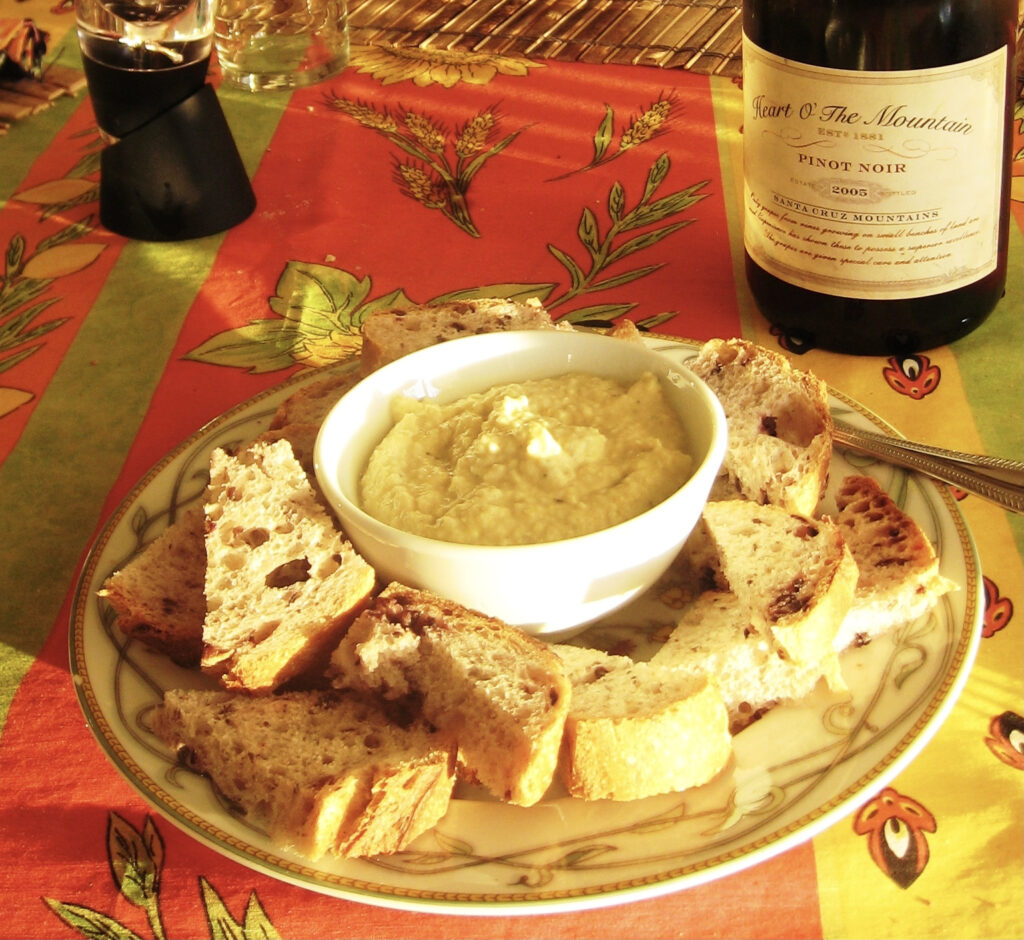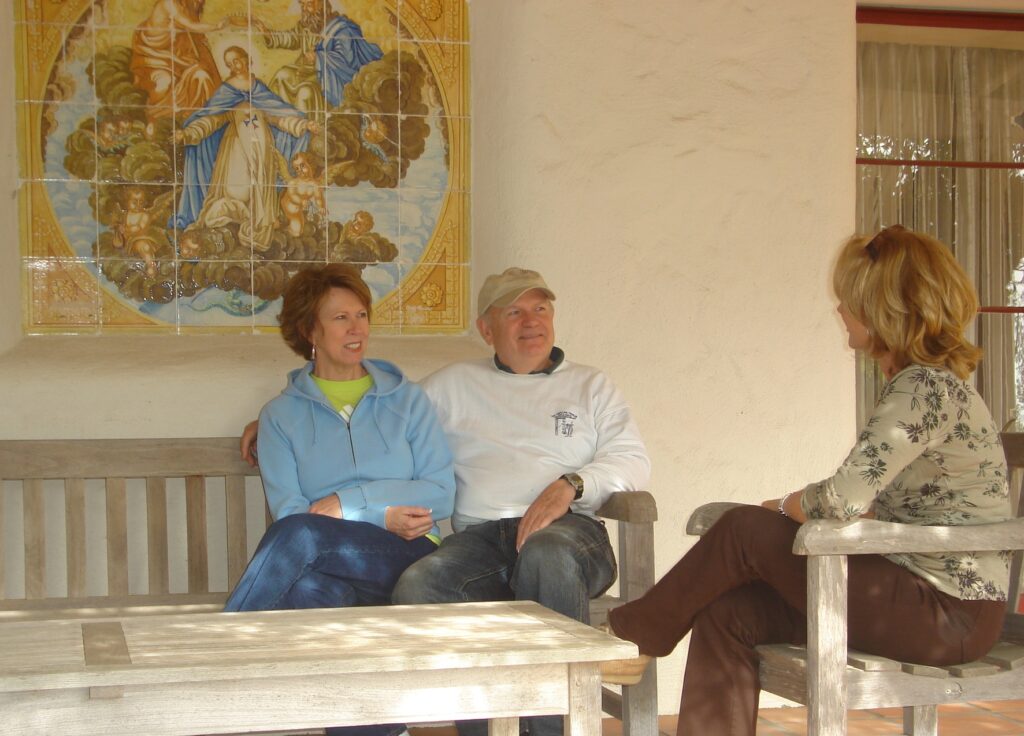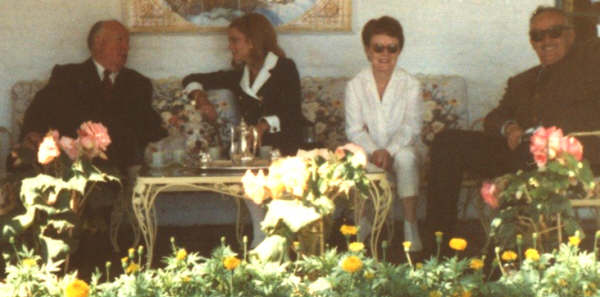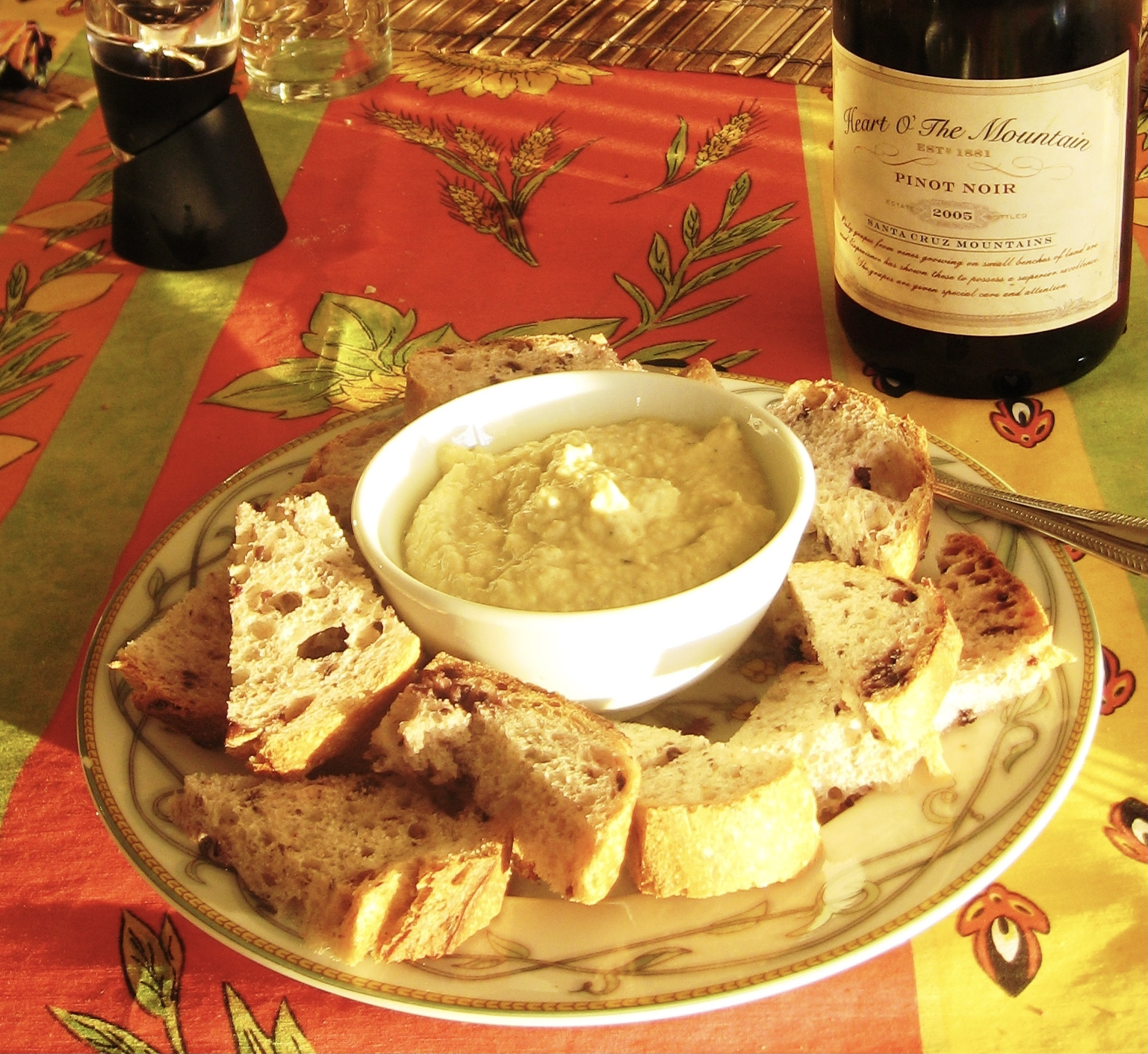A new Pinot Noir in the Santa Cruz Mountains
It’s a mild winter day when I head to the “secretive historic estate cradled in a glen among a deep forest of the Santa Cruz Mountains.” I left Highway 17 at the Scotts Valley Exit and drive straight up towards the mountain until I get on a dirt road that winds up, and unexpectedly down.
It begins to make sense that Alfred Hitchcock was attracted to such scenery. The thrill maker’s craze for the creepy is even getting to me. Anthropomorphic trees stare like ghostly onlookers clutching shreds of Spanish moss. It seems that I am on the set of a thriller, the knotty limbs of the forest elders leaning toward my intrusion. After many, many turns, a massive black gate opens onto young vines running down the incline. Beyond, the asphalted road is still a test of faith. Sharp edges disappear at every bent, letting me guess where the right side of the single lane is. Hitchcock couldn’t have cared less since he didn’t drive. Another sharp turn leads down to a mossy and rather romantic bridge. I am then let through another gate, with a grape-and-vine design, and come upon a graceful white house with a red-tiled roof, curved flowerbeds, trees beaded with citrus fruit, and groups of dormant bushes. The drive ends by the tower that was Hitchcock’s guest-house and is today the Heart O’ the Mountain emblem.
Robert and Judy Brassfield greet me, kindly asking about the drive up as we sit under a vine-covered pergola. As I look over the valley blanketed by the winter fog, Judy says their view extends “all the way to the Monterey Bay, on a sunny day.”
The New Heart O’ The Mountain Vineyard
The vines are young, but the vineyard goes back to the 1800s, Robert explains, when pioneer winemakers were determined to make good wines from mountain grapes. The connection with Hitchcock is that he grew and sold grapes after he bought the estate.
The Brassfields didn’t think of grapes when they bought the 155 acres estate, in 1978. “There was no vineyard,” Robert recalls. Then, one day, they were roaming their land when they discovered old vines among the thick brush, and what might have been the foundations of a winery. Intrigued, they did some research that would bring back the region’s prominent family names.
The first owner was Pierre Cornwall, a member of the First California Legislature. He had bought the property as a land grant, in 1881. He labeled his wine Santa Sada—the name of his second wife. And in her diary about “the farm,” the Brassfields discovered the estate’s historic name—Heart O’ The Mountain.
Robert and his son Brandon run a hands-on operation and enjoy the freedom of crafting their first pinot noir—Robert’s younger son, Dustin, runs his own winery above Lake County under the label High Valley. The Brassfields wanted to make wine for their enjoyment but pouring at several tasting events of the Santa Cruz Winegrowers Association led to their first release.
The Santa Cruz Vintners of the Past
It had been a long journey until the late 1800s when a few pioneers formed the Santa Cruz Mountains Wine Company, then tunneled large cellars into the cliffs.
Among them were John and Georges Jarvis who, in 1860, acquired the newly clear-cut area and tilled the land to plant “mission grapes” originally introduced by missionaries. These were not easy times, even ten years later when the 1870 Report on the State of the Wine Industry of Alta California totally ignored them. What’s more, in 1874 they faced had to (successfully) fight back against the temperance movement bill—initiated by the Order of Good Templars.
Eventually, other winemakers emerged, and with them, thousands of acres. The wine trade boomed until entrepreneurship led to speculation and a disastrous lack of business foresight. Growers were obsessed with the per-acre yield, ignoring the inadequacy of their facilities and winemaking practices.
It was a pricey mistake. Dealers bought entire cellars. To make matters worse, they sold good wines under foreign labels—stripping Santa Cruz of a legitimate validation. Worst still, bad wines were sold cheaply as California Wine. Grapes became feed for pigs and turkeys and the market collapsed. Wineries closed, and heavily indebted growers switched to walnuts and fruit. Others grafted stock for raisins.
However, within a decade of the debacle, the industry was reborn. Vine Hill acquired a fine reputation with George Bram’s white Riesling and Semillon, Henry Mel of Fontenay Vineyard and his Meunier and Chauche Noir, and Dr. John A. Stewart of Etta Hill Vineyard even won prizes at the 1893 Chicago Fair for his white Burgundy—attributed to pruning vines close to cordons. He was the first to blend wines in the French way, winning prizes at world fairs—Paris in 1889, Chicago in 1893, and San Francisco in 1894.
Across the hill to the west, the Ben Lomond Wine Company—founded by Scotsman John Burns, and eventually run by William Cooper—produced a Grey Riesling with the “thin, delicate, flinty dryness of a true Chablis” so described in 1889 by wine expert Frona Wait—in her book on California wines. It was prized at the 1900 Paris Exposition.
Success had settled in when economic recession, Prohibition, and personal hardship again crushed the industry. “There are so many stories,” Bob says. Those of Emil Meyer of Mare Hill Vineyards, for example. To his surprise, only his rootstock resisted the root-loose infestation that ruined most vineyards. And, in 1899, when the water supply dried up, he hooked up fire hoses to his claret vats to save his winery from the raging fires that consumed the mountains.
Wine expert Matt Kramer called the area “California’s all-time underrated wine district,” praising its “absolute uniqueness.” Since experts know best, wine collectors should take notice.
The vision of the founding fathers of the Santa Cruz Mountains Viticulture had been worth fighting for. “They validated the terroir for future generations,” Robert says.
Today, some 70 wineries stretch over 350,000 acres under the Santa Cruz Mountains Viticultural Appellation, federally recognized in 1981. The domain extends from Half Moon Bay in the north to Mount Madona in the south. Surprisingly, East and West are defined by elevation, down to 800 feet in the east and 400 feet in the west.
Winemaking at Heart O’ The Mountain
If the past is a good indication of the future, Heart O’ the Mountain will thrive in the former Vine Hill vineyard district. A warm cocoon by day, cooled off at night by the marine breeze, its micro-climate at 1100 feet of elevation slows the maturing of the grapes and concentrates the flavors. What’s more, the small benches of land on steep slopes with the soil of loam, sand, clay, and chalk appropriately stress the vines while strengthening their rootstock, “a perfect terroir for pinot noir,” Robert says.
But winemaking is also a matter of personal techniques. The Brassfields believe that “a wine should be first about the vineyard it comes from.” They favor nature as a helper, as they do in their ranch of Quincy where they raise cattle under the Thomson Valley Natural Grass-Fed Beef Label. At the winery, they use gravity to let the juice flow from the outdoor press to the stainless-steel tanks inside the 1400-square-foot winery.
Their 2005 Pinot Noir is a blend of three Pinot Noir clones: two from the Dijon region and one from Pommard. Aged to perfection in the finest French and Hungarian oak barrels, the wine exhibits “soft supple tannins with a back-note of spice and elegant touches of blackberry and raspberry.” And it placed second at a blind panel of the International Pinot Noir Shootout in San Francisco, in 2008.
With limited production, the wine is only available through a yearly allocation. The Brassfields “hope to gather a convivial group of people for private tastings at the future winery.” A businessman who traveled the world, Robert now prefers simplicity. “What matters, is the process of hand-crafting quality wines, and being able to enjoy them with people interested in our progress.”
Next year’s 2006 release gets their meticulous attention. Aging each clone separately in a variety of new French oak barrels will reveal unique characteristics. Recently racked from new barrels to one-year-old barrels—to limit the oak presence and preserve the rich fruit flavors—the vintage is already meeting expectations as a complex, multi-layered wine, rich in color, and with supple tannins.
As for the 2007 harvest, warm weather gave an early start, which slowed as the weather cooled. As a result, the fruit hung longer, bringing the sugar, acid, and flavors into perfect balance. With a smile and a few nods, Robert can “hardly wait for the 2009 release.”
A Tour of Hitchcock Old Stomping Grounds
Owners since 1978, Robert and Judy met Pat Hitchcock O’Connell and her family on several occasions. An actress in some of her father’s films, she shared many memories.
As we tour the property, Robert briefs me on Hitchcock’s history on the premises. The filmmaker took a liking for the area in 1940 while shooting Rebecca with actress Joan Fontaine whose parents lived nearby, in Los Gatos. When the Hitchcocks bought the two-hundred-acre property, it included a farmhouse, cows, chickens, and a horse—they kept the caretaker and his family.
The house was renovated and enlarged, but most of the interior features are original. Judy points to the impressive stainless-steel O’Keefe & Merritt gas-powered stove with multiple ovens. And indeed, none of the corridors are straight, curved or bent instead, in a deliberate Hitchcock way.
Other than making thrillers, Hitchcock loved a good time with friends, among which Ingrid Bergman and her family, Jimmy Stewart, and Kim Novak. A photograph shows that we are sitting where Prince Rainier and Grace Kelly once sat—from the allegorical tiled mural on the wall.
The gardens were designed by the local artist Roy Rydell. The mosaic with doves—commissioned to Georges Braque and seen on vintage photographs of the (white) rose garden wall, and posters—was dismantled when the house was sold. Friendly statuaries in secretive patios and courtyards add charm to the mystery. A serene walkway under a long wood framework supporting an elderly wisteria leads to the pool.
As I later snail-drive down the mountain flank, I can’t help imagining that, with such a historic and entertaining background, the Heart O’ The Mountain’s future releases could be named The Legislator’s Reserve, The Director’s Reserve, and the Revival’s Reserve. All with a tinge of Hollywood finish.
First published 2008 Orato.com




